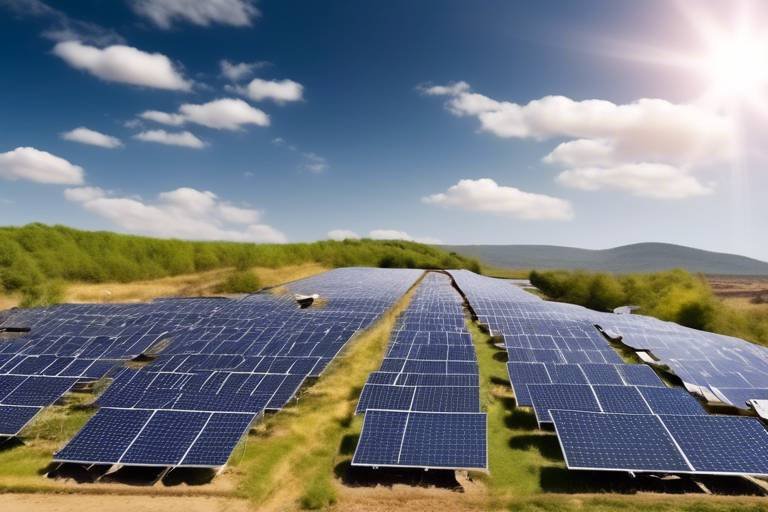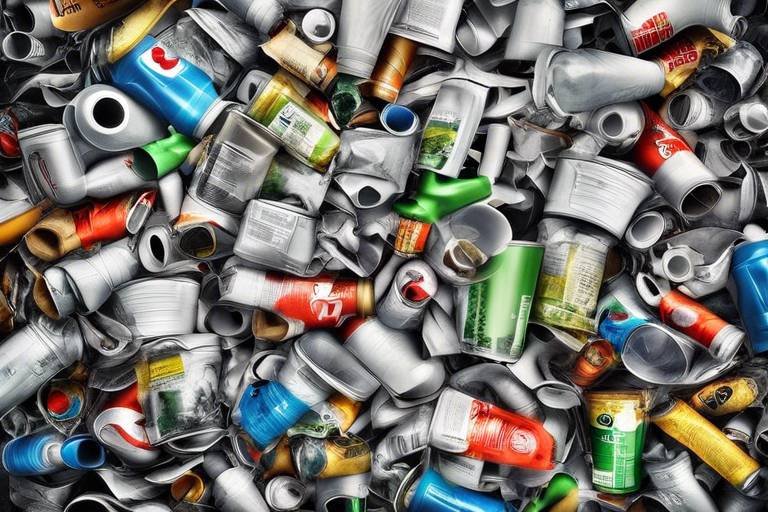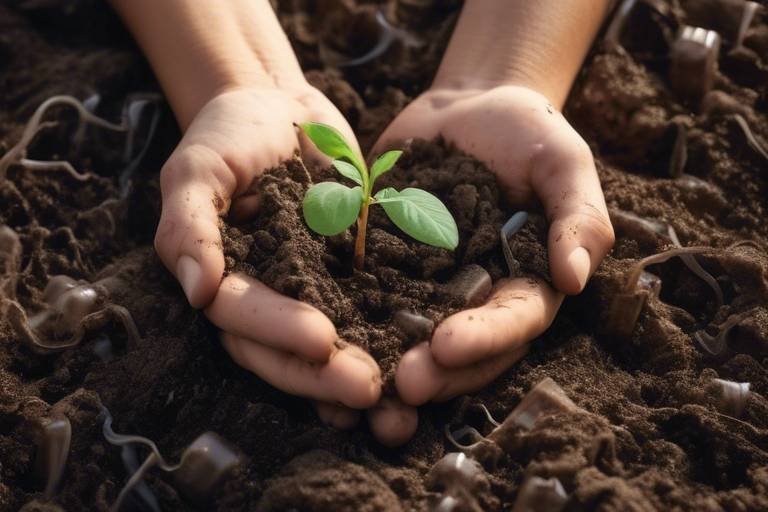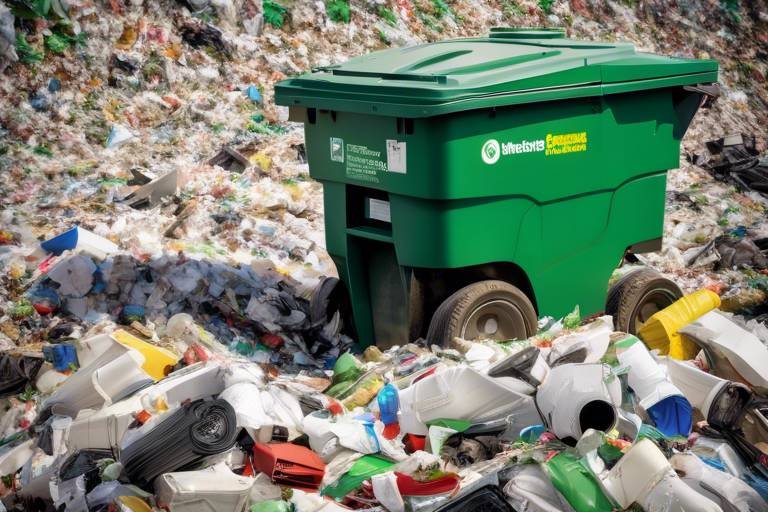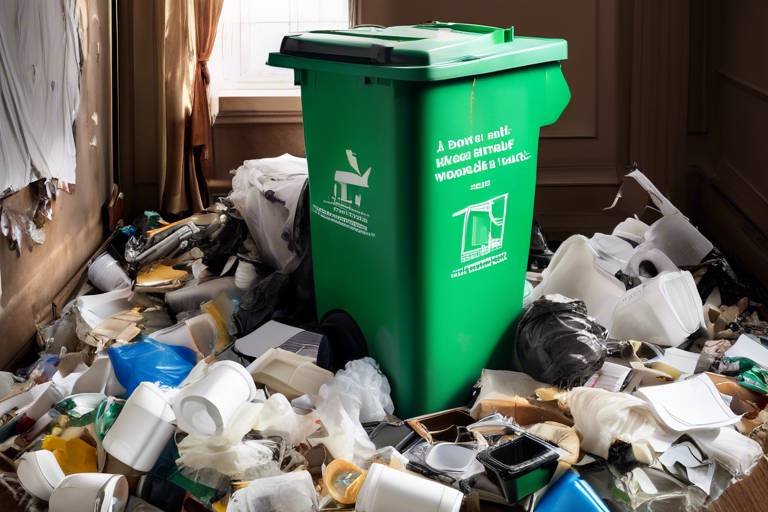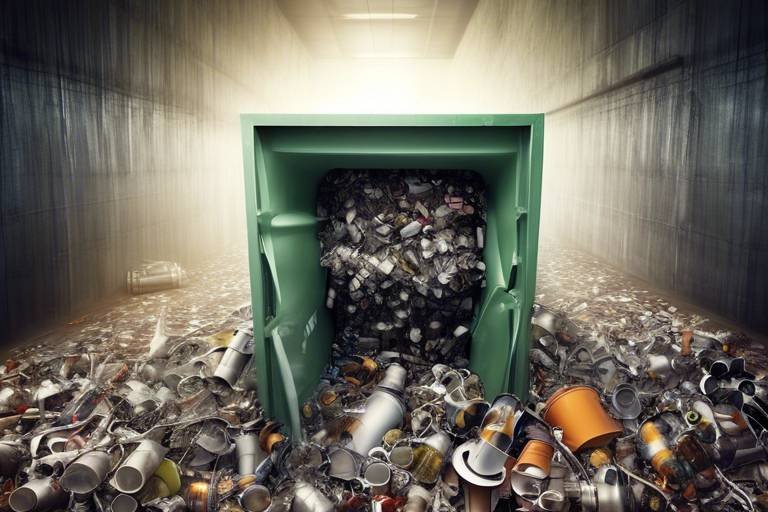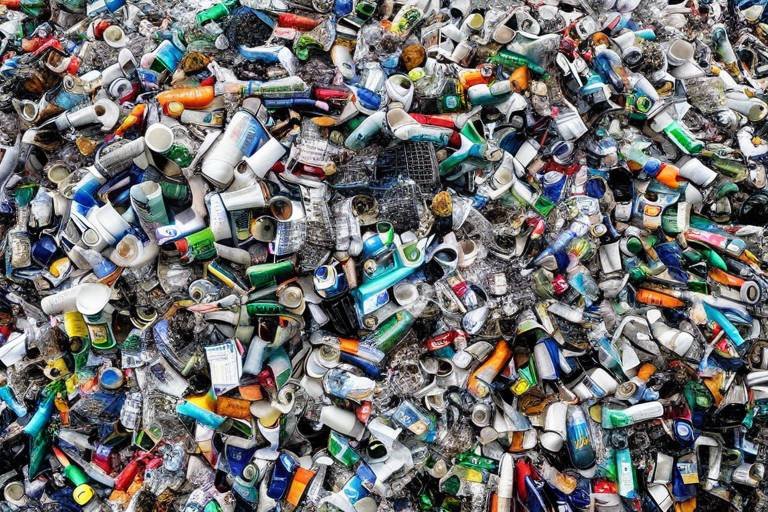What’s the Difference - Compostable, Biodegradable, Degradable?
Understanding the terms compostable, biodegradable, and degradable is crucial in today’s eco-conscious world. These words often get tossed around in conversations about sustainability, but do you really know what they mean? It’s like trying to tell apart cousins at a family reunion—similar, yet distinct in their own right. In this article, we will dive deep into these terms, unraveling their differences and exploring their environmental impacts. By the end, you’ll be equipped to make informed choices about the materials you use every day.
Let’s start with the basics. Compostable materials are those that can break down into natural, non-toxic substances when placed in a composting environment. Think of it as a magical transformation where food scraps, yard waste, and certain packaging turn back into nutrient-rich soil. This process typically requires specific conditions such as moisture, heat, and microorganisms to thrive. On the other hand, biodegradable items can decompose through natural processes, but the timeline for this breakdown can vary significantly. Some biodegradable products might take a few weeks, while others could linger for years, creating a bit of a dilemma for waste management. Lastly, degradable products break down over time, but here’s the catch—they often leave behind harmful residues that can pollute our environment.
In the following sections, we will take a closer look at each category, exploring their definitions, benefits, and the implications they hold for our planet. From food packaging to household items, understanding these differences can empower us to make choices that align with our sustainability goals. So, buckle up as we embark on this enlightening journey through the world of sustainable materials!
Compostable materials are a shining star in the realm of sustainability. They break down into natural substances in a composting environment, enriching the soil and supporting plant growth. Imagine tossing your leftover vegetable peels into a compost bin and, after some time, watching them transform into rich, dark compost that nourishes your garden. That’s the beauty of compostable materials!
For a product to be considered compostable, it must meet specific criteria. These include:
- Breaking down within a certain timeframe, typically 90 to 180 days.
- Turning into non-toxic byproducts that can safely enrich the soil.
- Being made from organic materials, such as plant-based plastics or food waste.
The benefits of using compostable products are numerous. Not only do they reduce landfill waste, but they also contribute to a circular economy by returning nutrients to the earth. By choosing compostable products, you’re not just making a purchase; you’re investing in a healthier planet.
Now, let’s shift gears and talk about biodegradable products. These items can decompose through natural processes, but here’s where it gets tricky—the timeframe for decomposition can vary widely. Some biodegradable materials break down in a few months, while others might take years, depending on environmental conditions.
Biodegradable products can be made from various materials, including:
- Natural fibers like cotton and jute.
- Plant-based plastics derived from corn or sugarcane.
- Paper and cardboard products.
While biodegradable products offer a step in the right direction, they can still pose challenges for waste management. If they end up in a landfill, the lack of oxygen can slow down the decomposition process, leading to the same issues as traditional plastics. Understanding where and how to dispose of biodegradable items is essential for maximizing their environmental benefits.
Degradable items are a bit of a mixed bag. While they do break down over time, they often leave behind harmful residues that can contaminate soil and waterways. This category includes many conventional plastics that are treated with additives to accelerate their breakdown process. However, the end result is often microplastics, which pose significant threats to wildlife and ecosystems.
In essence, while degradable items may seem like a better option than traditional plastics, they can still contribute to environmental degradation. It's crucial to be aware of what you're using and to consider alternatives that are truly sustainable.
Understanding the environmental impact of compostable, biodegradable, and degradable materials is vital for making informed choices. Each type affects ecosystems and waste systems differently. Compostable materials can enhance soil health, while biodegradable products can vary in their effectiveness depending on disposal methods. Degradable items, however, often leave harmful residues, posing risks to our planet.
Compostable materials are increasingly finding their way into various industries. From food packaging to utensils, their applications are promoting sustainability in exciting ways. Restaurants are opting for compostable takeout containers, and events are using compostable cutlery to minimize waste. It's a win-win for both businesses and the environment!
Biodegradable products are becoming more common in households. Items like biodegradable trash bags and personal care products are gaining popularity as consumers become more eco-conscious. By incorporating these products into your daily life, you contribute to reducing landfill waste and promoting a healthier planet.
While degradable items offer some benefits, they also present challenges. The potential for harmful residues and the lack of clear disposal guidelines can create confusion for consumers. It's essential to be aware of these issues to make responsible choices.
Making informed choices about materials is essential for sustainability. When selecting between compostable, biodegradable, or degradable products, consider your specific needs and environmental goals. Look for certifications and labels that indicate a product's sustainability, and don’t hesitate to ask questions about disposal methods.
The future holds promise for innovative materials that enhance sustainability. Emerging trends in compostable and biodegradable technologies are paving the way for a greener tomorrow. As consumers demand more eco-friendly options, companies are stepping up to meet these needs, creating a ripple effect that benefits our planet.
Q: What is the main difference between compostable and biodegradable?
A: Compostable materials break down into non-toxic substances in a composting environment, while biodegradable materials can decompose through natural processes but may take longer and could leave harmful residues.
Q: Can I compost biodegradable products?
A: Not all biodegradable products are compostable, so it’s essential to check for specific composting certifications before placing them in your compost bin.
Q: Are degradable materials environmentally friendly?
A: Degradable materials can break down over time, but they often leave harmful residues, making them less environmentally friendly compared to compostable options.

Understanding Compostable Materials
When we talk about compostable materials, we’re diving into a world where waste transforms into something beneficial—soil! Unlike traditional waste, compostable items break down into natural substances in a composting environment, enriching the earth instead of polluting it. But what exactly does that mean? Let's unpack it.
Compostable materials require specific conditions to break down effectively. Think of it like a recipe: you need the right ingredients and environment. Typically, these materials thrive in warm, moist, and oxygen-rich environments. This means that simply tossing them into your regular trash won’t cut it; they need to be sent to a composting facility or a home compost pile where they can decompose properly. The ideal composting conditions include:
- Temperature: A compost pile should reach temperatures between 130°F to 160°F (54°C to 71°C) to kill harmful pathogens and speed up decomposition.
- Moisture: The materials should be damp but not soggy. Think of a wrung-out sponge—just the right amount of moisture!
- Oxygen: Regular turning of the compost pile allows air to circulate, which is vital for the microbes that break down the materials.
The benefits of using compostable products are numerous and impactful. Not only do they reduce the amount of waste that ends up in landfills, but they also contribute to soil health by returning nutrients back to the earth. Imagine a cycle where waste becomes food for the soil, which in turn grows more food! This is the magic of composting.
Moreover, compostable materials can significantly reduce greenhouse gas emissions. When organic waste decomposes in a landfill, it produces methane, a potent greenhouse gas. However, when composted properly, these materials break down aerobically, minimizing harmful emissions. In essence, using compostable products is like giving Mother Earth a big hug!
It’s important to note that not all biodegradable items are compostable. While all compostable materials are biodegradable, not all biodegradable materials can break down in a composting environment. For instance, some biodegradable plastics may require industrial facilities to decompose, which aren't available everywhere. Therefore, understanding the distinction is crucial for making environmentally friendly choices.
In conclusion, compostable materials are more than just a trend; they represent a sustainable practice that benefits our planet. By choosing compostable options, you’re not only reducing waste but also nurturing the earth for future generations. So the next time you’re out shopping, consider reaching for that compostable bag or container—it’s a small step that leads to a giant leap for sustainability!

Exploring Biodegradable Products
When we hear the term biodegradable, it often conjures up images of products that are friendly to our planet. But what does it really mean? Biodegradable products are those that can be decomposed by natural processes, primarily by microorganisms like bacteria and fungi. This decomposition can happen in various environments, which is one of the reasons why biodegradable products are gaining popularity in our eco-conscious society.
However, the timeframe for biodegradation can vary significantly. Some materials might break down in a matter of weeks, while others could take years. This variability can depend on several factors, including temperature, moisture, and the presence of oxygen. For instance, a banana peel can decompose in about 3 to 4 weeks under optimal conditions, while a plastic bag might take hundreds of years if left in a landfill. This highlights the importance of understanding what we’re using and how it will impact the environment.
So, what types of materials fall under the biodegradable umbrella? Here are a few common examples:
- Food waste: Naturally decomposes and can be composted.
- Paper products: Such as cardboard and certain types of packaging.
- Natural fibers: Like cotton and wool, which break down relatively quickly.
- Bioplastics: Made from renewable resources and designed to decompose more readily than traditional plastics.
While biodegradable products are a step in the right direction, they are not without their challenges. One major concern is the misconception that biodegradable items can just be tossed anywhere and will break down naturally. In reality, many biodegradable products require specific conditions to decompose effectively, often found in industrial composting facilities rather than in typical landfill environments. This can lead to confusion among consumers and a false sense of security regarding their disposal.
Moreover, the term "biodegradable" can sometimes be misleading. Some products labeled as biodegradable may still take a long time to break down, or they might leave behind harmful residues that can affect soil and water quality. Therefore, it’s crucial for consumers to educate themselves about the products they choose. Understanding the differences between biodegradable, compostable, and traditional materials can empower individuals to make more informed decisions that align with their sustainability goals.
In summary, biodegradable products represent a significant opportunity for reducing waste and minimizing our environmental footprint. By choosing biodegradable options, we can contribute to a healthier planet. However, it’s essential to be aware of their limitations and ensure proper disposal methods. As we continue to explore sustainable materials, the choices we make today will pave the way for a greener tomorrow.
1. What is the difference between biodegradable and compostable?
Biodegradable materials break down into natural substances but may not necessarily enrich the soil, while compostable materials break down under specific conditions and contribute nutrients to the soil.
2. How long does it take for biodegradable products to decompose?
The decomposition time varies widely depending on the product and environmental conditions, ranging from weeks to several years.
3. Can I throw biodegradable items in my regular trash?
It's best to check local waste management guidelines. Many biodegradable products require industrial composting facilities to break down effectively.
4. Are all biodegradable products environmentally friendly?
Not necessarily. Some biodegradable products may still leave harmful residues or take a long time to decompose, so it's important to research specific items.

The Concept of Degradable Items
When we talk about degradable items, we enter a gray area in the world of sustainable materials. Unlike compostable and biodegradable products, degradable items are designed to break down over time, but they don't necessarily do so in a way that's safe for the environment. Think of them as the awkward middle child in the family of materials; they have some good qualities, but they also come with a few unwanted traits.
So, what exactly makes a product degradable? Generally, it refers to materials that can undergo a chemical process that leads to their breakdown. However, the process often involves additives that accelerate degradation, which can leave behind harmful residues. This raises a crucial question: if something breaks down but leaves toxic remnants, can we truly consider it environmentally friendly? The answer is not as straightforward as one might hope.
To illustrate this point, let's look at some common characteristics of degradable items:
- Breakdown Process: Degradable products may break down through exposure to sunlight, oxygen, or moisture, but this doesn't guarantee complete decomposition.
- Environmental Impact: The breakdown can result in microplastics or other harmful substances that can pollute our soil and waterways.
- Timeframe: The time it takes for degradable items to break down can vary widely, sometimes taking years, depending on environmental conditions.
One of the most significant concerns surrounding degradable items is their potential to contribute to plastic pollution. While they may seem like a better alternative to traditional plastics, the reality is that many degradable products still end up in landfills, where they can take far longer to degrade than intended. This leads to a paradox: in our quest for sustainability, we might inadvertently be creating new problems.
Moreover, the labeling of products as "degradable" can sometimes be misleading. Without proper regulations, manufacturers can make claims that aren't backed by science, leading consumers to believe they are making environmentally responsible choices when, in fact, they might not be. This is why it's essential to look beyond the labels and understand the full lifecycle of the products we use.
In summary, while degradable items offer a step in the right direction compared to conventional plastics, they are not a silver bullet for environmental issues. As consumers, we must remain vigilant and informed, making choices that genuinely contribute to a healthier planet. Understanding the nuances of what makes a product degradable can empower us to advocate for better alternatives that prioritize our ecosystem's health.
- What is the difference between biodegradable and degradable? Biodegradable materials break down naturally into non-toxic components, while degradable materials may leave behind harmful residues.
- Are all degradable items harmful? Not all degradable items are harmful, but many can contribute to pollution if they don't break down completely.
- How can I identify degradable products? Look for certifications or labels that indicate environmental impact, and do some research on the manufacturer's claims.

Environmental Impact of Each Type
The environmental impact of materials we use daily cannot be overstated. Understanding the differences between compostable, biodegradable, and degradable items is crucial for making informed choices that benefit our planet. Each type of material interacts with the environment in distinct ways, influencing everything from soil health to waste management systems.
Compostable materials are often heralded as the champions of sustainability. When disposed of in a suitable composting environment, they break down into natural substances, enriching the soil with nutrients. This process not only reduces landfill waste but also promotes healthy ecosystems. However, it's essential to note that compostable items require specific conditions—such as heat, moisture, and microbial activity—to decompose effectively. If they end up in a landfill, the benefits they offer can be lost, as anaerobic conditions hinder the composting process.
On the other hand, biodegradable products decompose through natural processes, but the timeframe for this breakdown can vary significantly. Some biodegradable materials may take months, while others could linger for years before fully decomposing. This variability can pose challenges for waste management, especially if biodegradable items are mixed with non-biodegradable waste. Inadequate disposal methods can lead to environmental pollution, as these products may not break down efficiently in landfills, releasing harmful substances into the soil and groundwater.
Then we have degradable items, which sound beneficial at first glance. These products are designed to break down over time, but the catch is that they often leave behind harmful residues. Many degradable materials rely on additives that hasten their breakdown but do not eliminate their toxic components. This can lead to microplastics and other pollutants entering our ecosystems, posing risks to wildlife and human health. The long-term environmental consequences of using degradable materials are still being studied, but initial findings suggest that they may not be as eco-friendly as they appear.
To further illustrate the differences in environmental impact, consider the following table:
| Type | Breakdown Process | Environmental Impact |
|---|---|---|
| Compostable | Breaks down into natural substances in composting conditions | Enriches soil, reduces landfill waste |
| Biodegradable | Decomposes through natural processes, timeframe varies | Potential for pollution if not disposed of properly |
| Degradable | Breaks down over time, often leaves residues | Can contribute to microplastic pollution |
In conclusion, the environmental impact of compostable, biodegradable, and degradable materials is complex and multifaceted. While compostable materials offer significant benefits when processed correctly, biodegradable and degradable options present challenges that can undermine their sustainability claims. By understanding these distinctions, we can make better choices that align with our environmental goals and contribute to a healthier planet.
- What is the main difference between compostable and biodegradable?
Compostable materials break down into nutrient-rich compost in specific conditions, while biodegradable materials decompose over time but may not enrich the soil. - Can biodegradable products be recycled?
It depends on the material. Some biodegradable products can be recycled, but many cannot, and mixing them with traditional recyclables can contaminate the recycling stream. - Are degradable items harmful to the environment?
Yes, degradable items can leave behind harmful residues, contributing to pollution and microplastic issues in ecosystems. - How can I ensure I'm using sustainable materials?
Look for certifications and labels indicating whether a product is compostable or biodegradable, and choose materials that are designed for proper disposal.

Applications of Compostable Materials
In today's world, where sustainability is more than just a buzzword, compostable materials are leading the charge in various industries. These materials offer a way to reduce waste and enrich the soil, making them an essential component in our quest for a greener planet. So, what exactly are the applications of these eco-friendly wonders? Let’s dive into some of the most prominent uses!
One of the most significant applications of compostable materials lies in the realm of food packaging. Traditional plastic packaging contributes massively to landfill waste, but compostable alternatives are stepping up to the plate. For instance, many restaurants and food vendors are now opting for compostable containers and utensils. These items not only serve their purpose during the meal but also break down into nutrient-rich compost after disposal, enhancing soil health. Imagine a world where your takeaway containers contribute to the growth of new plants instead of sitting in a landfill for centuries!
Moreover, compostable materials are making a splash in the agricultural sector. Farmers are increasingly using compostable mulch films to cover their crops. Unlike conventional plastic films that can harm the environment, these compostable options decompose naturally, returning valuable nutrients to the soil. This practice not only promotes healthier crops but also reduces the need for plastic disposal, creating a win-win situation for both farmers and the ecosystem.
Another exciting application can be found in the realm of events and celebrations. From weddings to festivals, the use of compostable plates, cups, and cutlery is on the rise. These items allow event organizers to provide a sustainable option for their guests, minimizing the environmental impact of large gatherings. It’s like throwing a party that not only celebrates life but also respects our planet!
In addition to these applications, compostable materials are also being utilized in the production of consumer goods. Items such as compostable trash bags, mailers, and even personal care products are hitting the shelves. These products cater to eco-conscious consumers who want to make responsible choices without sacrificing convenience. It's a shift towards a lifestyle that prioritizes sustainability, showing that even the smallest changes can lead to significant impacts.
To summarize, the applications of compostable materials are diverse and impactful. They not only provide practical solutions across various industries but also foster a culture of sustainability. Whether in food service, agriculture, events, or everyday products, compostable materials are paving the way for a cleaner, greener future. As we continue to innovate and explore new uses for these materials, the possibilities are endless!
- What are compostable materials? Compostable materials are organic substances that can break down into natural elements in a composting environment, enriching the soil.
- How long does it take for compostable materials to decompose? Compostable materials typically decompose within 90 to 180 days under the right conditions.
- Can compostable materials be recycled? No, compostable materials should not be recycled with traditional plastics; they are specifically designed to break down in composting facilities.
- Are compostable materials more expensive than traditional options? While compostable materials can be slightly more expensive, the long-term environmental benefits often outweigh the initial costs.

Biodegradable Products in Daily Life
In our fast-paced world, the quest for sustainability has led to an increasing presence of biodegradable products in our daily lives. These items are designed to break down naturally, reducing their impact on the environment. Imagine tossing a product into the trash, only to realize that it will decompose over time, returning to the earth instead of lingering in a landfill for centuries. Isn’t that a comforting thought?
Biodegradable products come in various forms and are often made from natural materials, such as plant-based substances. Common examples include biodegradable bags, utensils, and even packaging materials. You might be surprised to learn that many of the products we use every day can be replaced with biodegradable alternatives. For instance, think about your morning coffee ritual. Instead of using a traditional plastic cup, you could opt for a biodegradable cup made from cornstarch. Not only does it serve its purpose, but it also contributes to a healthier planet.
Let’s take a closer look at some of the most popular biodegradable products that have made their way into households:
- Compostable Trash Bags: These bags break down in composting environments, making them a fantastic choice for reducing waste.
- Biodegradable Cutlery: Made from materials like PLA (polylactic acid), these utensils decompose after use, making picnics and parties more eco-friendly.
- Packaging Peanuts: Instead of traditional foam, biodegradable packing peanuts are made from starch and dissolve in water, leaving no trace behind.
- Toothbrushes: Bamboo toothbrushes are gaining popularity as a sustainable alternative to plastic, offering a biodegradable option that doesn’t compromise on quality.
Integrating biodegradable products into our lives doesn’t just help the environment; it also encourages a mindset shift. By choosing these options, we become more conscious consumers, recognizing the impact of our choices. It’s like planting a seed; every small decision contributes to a larger change. However, it’s essential to remember that not all biodegradable products are created equal. Some may require specific conditions to break down effectively, such as industrial composting facilities. Therefore, it’s vital to educate ourselves about the products we choose.
Moreover, the rise of biodegradable products has spurred innovation across various industries. Companies are increasingly investing in research to develop new materials that can decompose more efficiently without leaving harmful residues. This shift not only benefits the environment but also opens up new markets and opportunities for sustainable business practices. The future looks bright for biodegradable products, as they pave the way for a more sustainable lifestyle.
In conclusion, incorporating biodegradable products into our daily lives is a simple yet impactful way to contribute to environmental sustainability. By making conscious choices, we can reduce waste and inspire others to follow suit. Remember, every small step counts in the journey toward a greener planet!

Challenges with Degradable Materials
When we talk about degradable materials, it’s easy to get swept away by the idea that they are a perfect solution to our waste management woes. But hold on a second! Just like a shiny new toy, they come with their own set of challenges that can leave us scratching our heads. So, what exactly are these challenges?
First off, one of the most significant issues is the timeframe in which these materials break down. While they are designed to degrade over time, the process can be incredibly slow, sometimes taking years or even decades. This means that even if a product is labeled as degradable, it might still linger in our environment much longer than we’d like. Imagine tossing a degradable plastic bag into the ocean, thinking it will vanish in a few months, only to find it hanging around like an uninvited guest at a party.
Another major concern is the residues left behind after degradation. Unlike compostable materials, which break down into nutrient-rich soil, degradable items can break down into smaller pieces of plastic, known as microplastics. These tiny particles can be quite harmful, infiltrating our ecosystems and food chains. It’s like trying to clean up a spill by just spreading it out – you may not see the mess, but it’s still there, causing problems.
Furthermore, the disposal methods for degradable materials can be confusing. Many consumers assume that these products can be tossed into any recycling or compost bin. However, this is not the case. Degradable materials often require specific conditions to break down properly, conditions that are not always met in standard waste management systems. This leads to a situation where these items end up in landfills, where they may not degrade at all.
To put it into perspective, let’s look at some of the challenges associated with degradable materials:
| Challenge | Description |
|---|---|
| Slow Decomposition | Degradable materials can take years to break down, contributing to landfill overflow. |
| Microplastics | Degradation can result in harmful microplastics that pollute ecosystems. |
| Improper Disposal | Consumers may not know how to dispose of these materials correctly, leading to environmental harm. |
Let’s not forget the impact on wildlife. Animals can mistake these materials for food, leading to ingestion and potentially fatal consequences. It’s a harsh reality that highlights the importance of careful consideration when choosing materials. We might think we’re making a better choice, but if we’re not well-informed, we could be causing more harm than good.
In conclusion, while degradable materials may seem like a step in the right direction, they come with challenges that we cannot overlook. It’s essential for consumers to be aware of these issues and make informed decisions when selecting products. Remember, the goal is not just to reduce waste but to do so in a way that genuinely benefits our planet.
- What are degradable materials? Degradable materials are designed to break down over time, but they may leave harmful residues behind.
- How long do degradable materials take to decompose? The decomposition timeframe can vary greatly, often taking years or decades.
- Are degradable materials safe for the environment? Not always. They can create microplastics and may not decompose properly in landfills.
- What’s the difference between compostable and degradable? Compostable materials break down into nutrient-rich compost, while degradable materials may leave harmful residues.

Choosing the Right Option for Sustainability
When it comes to making choices that benefit our planet, understanding the differences between compostable, biodegradable, and degradable materials is crucial. Each of these options has its own unique characteristics and environmental implications, making it essential to choose wisely based on your specific needs and sustainability goals. Think of it like picking the right tool for a job; using the wrong one could lead to subpar results. So, how do you choose the right option?
First off, consider your end goal. If you want to enrich the soil and contribute to a circular economy, compostable materials are your best bet. These materials break down into nutrient-rich compost when disposed of properly in a composting environment. This means that not only do you reduce waste, but you also give back to the earth in a meaningful way. However, it's important to remember that compostable items require specific conditions to break down effectively, such as the right temperature, moisture, and aeration.
On the other hand, if you're looking for a more general solution, biodegradable products can be a good option. They decompose through natural processes, but the timeframe can vary significantly. Some biodegradable items might break down in a few months, while others could take years. This variability can make it challenging to manage waste effectively. For example, if you throw a biodegradable plastic bag into a landfill, it might not decompose at all due to the lack of oxygen and appropriate conditions. Therefore, it's essential to consider where and how these products will be disposed of.
Then we have degradable materials, which break down over time but can leave behind harmful residues. These materials often contain additives that speed up the breakdown process but may not fully disappear from the environment. If you’re opting for degradable products, it's crucial to be aware of their long-term environmental impact. They might seem like a quick fix, but they can contribute to pollution if not disposed of properly.
To help you navigate these choices, here’s a quick comparison table:
| Type | Breakdown Process | Environmental Impact | Best Use |
|---|---|---|---|
| Compostable | Breaks down into compost in a composting environment | Positive; enriches soil | Food packaging, utensils, organic waste |
| Biodegradable | Decomposes through natural processes, time varies | Varies; can lead to waste if not properly disposed | General waste, certain plastics |
| Degradable | Breaks down over time, may leave residues | Potentially harmful; can contribute to pollution | Single-use items, certain plastics |
Ultimately, the best choice depends on your lifestyle and values. Are you committed to reducing your carbon footprint? Do you have access to composting facilities? These questions can guide you toward the right materials. Remember, every small decision counts, and by making informed choices, you’re contributing to a more sustainable future.
- What is the main difference between compostable and biodegradable?
Compostable materials break down into nutrient-rich compost in a composting environment, while biodegradable materials can break down naturally but may not enrich the soil. - Can I compost biodegradable products?
Not all biodegradable products are compostable. Check for certification to ensure they can be composted effectively. - What happens to degradable materials in landfills?
Degradable materials may break down, but often they do not fully decompose and can leave harmful residues.

The Future of Sustainable Materials
The future of sustainable materials is not just a trend; it's a revolution in how we think about our planet and the products we use every day. As we become increasingly aware of the environmental challenges we face, the need for innovative solutions has never been greater. Imagine a world where every product you use—from your morning coffee cup to your shopping bags—contributes positively to the environment. This is not a distant dream but a reality that is rapidly taking shape.
One of the most exciting developments in this field is the advancement of bioplastics. These materials, derived from renewable sources like corn starch or sugarcane, not only reduce our reliance on fossil fuels but also have the potential to be compostable. Innovations in this area mean that we can create packaging that breaks down naturally, enriching the soil rather than polluting it. Companies are investing heavily in research to develop bioplastics that meet consumer needs while being environmentally friendly. For instance, major brands are exploring how to replace traditional plastic with these sustainable alternatives in their packaging.
Another promising avenue is the enhancement of recycling technologies. With the rise of smart recycling bins and AI-driven sorting systems, we can improve the efficiency of recycling processes. This means that more materials can be repurposed rather than ending up in landfills. As we develop better methods for sorting and processing recyclable materials, we can effectively close the loop on waste, turning what was once considered trash into valuable resources. The table below illustrates some of the innovative recycling technologies currently being explored:
| Technology | Description | Benefits |
|---|---|---|
| AI Sorting | Utilizes artificial intelligence to identify and sort recyclable materials. | Increases efficiency and accuracy in recycling processes. |
| Chemical Recycling | Breaks down plastics into their original monomers for reuse. | Allows for recycling of materials that are traditionally non-recyclable. |
| Biodegradable Plastics | Plastics that can decompose in natural environments. | Reduces plastic pollution and landfill waste. |
Moreover, the concept of a circular economy is gaining traction. This model emphasizes the importance of designing products with their entire lifecycle in mind. Instead of a linear model where products are made, used, and disposed of, the circular economy encourages manufacturers to consider how their products can be reused, repaired, or recycled. This shift not only minimizes waste but also fosters innovation in product design and resource management.
As we look ahead, it's crucial to address the challenges that accompany these advancements. While the potential is immense, we must also consider the economic implications of transitioning to sustainable materials. Will consumers be willing to pay a premium for eco-friendly products? How can we ensure that these materials are accessible to everyone? These questions are vital as we navigate the future landscape of sustainable materials.
In conclusion, the future of sustainable materials is bright and full of potential. With ongoing innovations in bioplastics, recycling technologies, and the circular economy, we have the opportunity to redefine our relationship with the planet. By embracing these sustainable practices, we can ensure a healthier environment for future generations. As consumers, we hold the power to drive change by supporting brands that prioritize sustainability. Together, we can create a world where every material serves a purpose beyond its initial use, contributing to a sustainable future.
- What are sustainable materials?
Sustainable materials are those that are produced and used in ways that do not harm the environment and can be replenished naturally. - How do bioplastics differ from traditional plastics?
Bioplastics are made from renewable resources and are often compostable, while traditional plastics are derived from fossil fuels and can take hundreds of years to decompose. - What is a circular economy?
A circular economy is an economic model that focuses on reusing, recycling, and reducing waste to create a closed-loop system, minimizing resource consumption.
Frequently Asked Questions
- What is the main difference between compostable and biodegradable materials?
Compostable materials break down into natural substances in a composting environment, enriching the soil, while biodegradable materials decompose through natural processes but may take longer and can leave behind harmful residues.
- Can all biodegradable products be composted?
No, not all biodegradable products are compostable. Compostable items require specific conditions to break down properly, whereas biodegradable products can decompose in various environments, sometimes leading to incomplete breakdown.
- How long does it take for compostable materials to decompose?
Compostable materials can take anywhere from a few weeks to several months to decompose, depending on the conditions such as temperature, moisture, and the type of material.
- Are degradable products safe for the environment?
Degradable products can break down over time, but they often leave behind harmful residues that can negatively impact the environment, making them less desirable compared to compostable options.
- What are some common examples of compostable materials?
Common compostable materials include food scraps, yard waste, compostable utensils, and certain types of packaging made from plant-based materials.
- How can I identify biodegradable products?
Look for labels that specifically state "biodegradable" or "compostable," and check for certifications from recognized organizations that ensure the product meets specific environmental standards.
- What challenges do degradable materials present?
Degradable materials can lead to environmental issues, such as pollution and harm to wildlife, due to their potential to leave behind microplastics and other harmful substances after they break down.
- How can I make sustainable choices when selecting materials?
To make sustainable choices, consider the lifecycle of the product, look for certifications, and prioritize compostable materials over biodegradable and degradable options when possible.
- What is the future of sustainable materials?
The future of sustainable materials looks promising with ongoing innovations in compostable and biodegradable technologies, aiming to reduce environmental impact and enhance sustainability in various industries.


